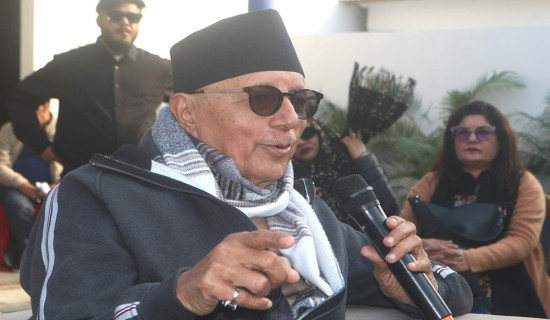- Sunday, 21 December 2025
Need To Tackle Food Insecurity
Food insecurity is looming large not only in Nepal but also all over the world. Climate change, conflicts such as the Ukraine war and other socio-economic factors are responsible for engendering a food crisis. In Nepal, experts have warned that risks of a food crisis have increased this year. The projection is based on an emerging situation of drought. Rainfall is expected to be below average this year. There was not sufficient rain in the winter as well. The monsoon rain is expected to be insufficient. This may give rise to drought. When a spell of drought gets prolonged, it affects agricultural production.
The Department of Hydrology and Meteorology has predicted that rainfall will be lower by 35 to 55 per cent this year. As per the notice published on Baisakh 21, Sudurpaschim, Karnali, Gandaki, some parts of Lumbini and southern parts of Koshi will receive 45 to 55 per cent less rainfall. The other parts will receive 35 to 45 less rainfall. The average rainfall this year is put at 1,700 millilitres.
Mainstay
Rain is the mainstay of agriculture in Nepal. Irrigation facilities are not up to the mark in the country. Farmers have to depend on rain for their agricultural activities in this agrarian nation. As per the 2078 census, 57.3 per cent of the population depends on agriculture. The number of people engaged in agricultural and allied activities has been declining over the years. In the past, over 90 per cent of the population was involved in agricultural and related activities. However, owing to the government’s apathy towards this important sector of the economy, people are gradually leaving the agricultural occupation.
Nepal was once an exporter of food grains. Now, the country has to import agricultural products from foreign countries, especially India. The country imported food grains worth Rs. 50.53 billion during the fiscal year 2078/79 B.S. People from the rural areas are leaving home for employment in the big cities of the country or in foreign countries, leaving their arable land barren. In big cities like Kathmandu, the arable land is being plotted out for residential purposes. The Kathmandu Metropolitan City has declared that there is no arable land in the metropolis.
In recent times, the bogeyman of food insecurity has raised its ugly head all over the world. Climate change is to blame for this undesirable phenomenon. On the other hand, the ongoing Ukraine war has disrupted the food supply chains to a greater extent. Russia and Ukraine are among the big exporters of food grains, petroleum products and chemical fertilisers. The war has generated a food crisis, thus hiking food prices. Those households with no or low incomes have been hit hard. Likewise, unemployed people have also borne the brunt of the war.
Ukraine provides over half of the World Food Programme’s wheat supply. What with reduced agricultural production and what with reduced exports from Ukraine and Russia, risks for food availability and affordability have emerged not only in Asia and sub-Saharan Africa but also in Europe. At the end of 2022, the World Food Programme conducted a survey in Nepal. The survey noted an increase in food insecurity with 17.8 per cent of the population, or 5.21 million people, not having an adequate diet. One in seven households did not have enough food to meet their daily requirements. The main reasons cited were food price hikes and lack of money. In fact, agricultural production has been declining over the years in Nepal.
Limited economic opportunities, natural disasters, inadequate market connectivity, conflicts, gender and caste discrimination, social and geographical inequalities and suchlike factors are also responsible for increasing food insecurity. Food security is taken as one of the fundamental human rights. In accordance with Article 36 of the Constitution of Nepal, people have the right to food, the right to be protected against food scarcity and the right to food sovereignty as provided by the law. There is provision for ending malnutrition, hunger and food insecurity in the Right to Food and Food Sovereignty Act, which was adopted in 2018.
One of the key objectives of the Sustainable Development Goals (SDGs) is to end hunger, achieve food security and improve nutrition and promote sustainable agriculture by 2030. The government allocates a budget for the agriculture sector every year. For the upcoming fiscal year 2080/81 B.S., the government has earmarked Rs. 55.89 billion, out of which Rs. 30 billion will be spent on the import of chemical fertilisers. So the remaining budget amount does not seem to be sufficient.
Domestic products
Nepal has a good agro-climate. There are sound prospects for agricultural development. But it seems the government has not paid adequate attention to developing the agricultural sector to the desired extent. The government has not made arrangements for transporting agricultural and other products to where they are required. Instead of doing so, the government prefers to import such products from foreign countries such as India. On one hand, the domestic products produced within the country are rotting away, while the country is spending hard-earned money on importing such products, on the other.
Moreover, the domestic products are far better than the foreign ones in terms of taste and quality. It is high time the government gave up its import mentality and encouraged the use of domestic products. By creating an enabling environment conducive to increasing agricultural production and productivity, food security can be ensured and food sovereignty can be gradually achieved, thus enabling the people to keep the wolf from the door.
(Maharjan has been regularly writing on contemporary issues for this daily since 2000.)











-(1)-original-thumb.jpg)




